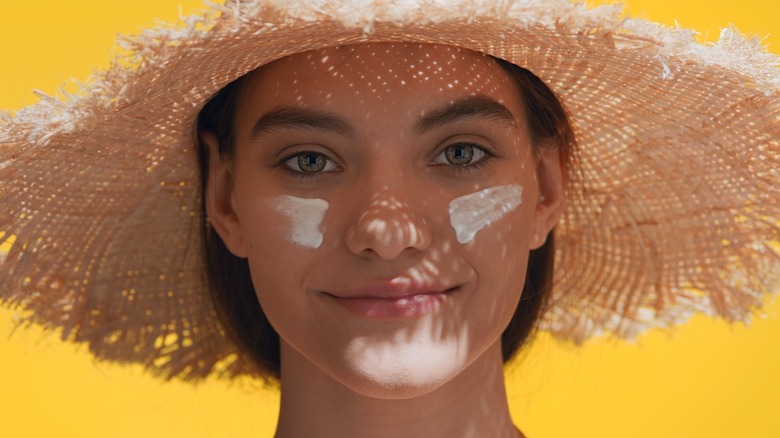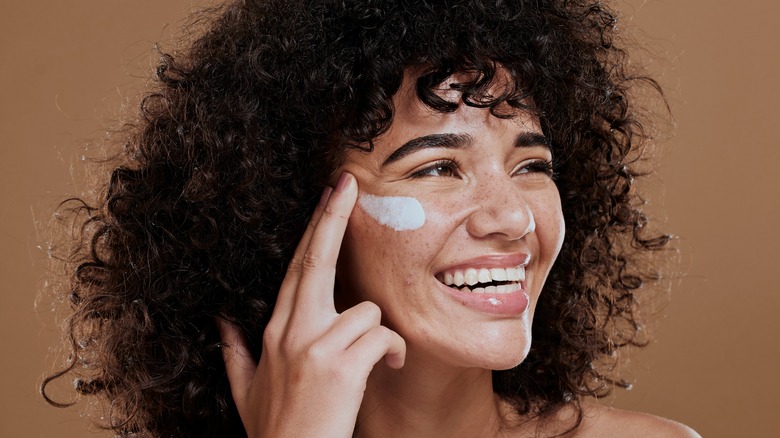The Easy Hack That Will Make Your SPF Melt Into Your Skin
Half the success of skincare lies in wearing sunscreen. Slathering up with sunscreen is the easiest and most effective way to shield your skin from ultraviolet (UV) radiation, preventing skin cancer, premature aging, and hyperpigmentation. Sunscreens contain active ingredients — also known as sun filters or ultraviolet filters — that protect the skin from damaging UV rays. Most sunscreens work by either absorbing, reflecting, or dispersing sun rays from the skin. There's no doubt that regular sunscreen application is essential for healthy skin, but there's a pet peeve that bothers even the most avid of sunscreen wearers — the white cast.
Since most physical or mineral sunscreens contain the white-colored sun-filtering components, titanium dioxide and zinc oxide, they can leave a white tint on your skin. This is because these ingredients stay on top of the skin's surface to protect it from sun damage, rather than absorbing it like chemical sunscreen. If you have pigmented skin, it can be difficult to avoid a white cast from sunscreen. Some white streaks here and there are nothing in the grand scheme of things, but they can make your skin look uneven compared to other parts of your body. Although the white cast is normal and inevitable, there are ways you can try to make your sunscreen blend into your skin and minimize the irrelevant white sheen.
Ways to help sunscreen blend into your skin
If you're always having problems with the white cast after applying physical or mineral sunscreen, you can try chemical sunscreen. Unlike physical sunscreen, chemical sunscreen has a thinner consistency and spreads more evenly over the skin's surface, leaving it silky smooth after application. As far as protection goes, chemical sunscreen also works differently than physical sunscreen. Chemical sunscreen is akin to a sponge that absorbs the sun's rays, while physical sunscreen acts like a shield to deflect damaging solar rays from your skin.
Alternatively, you can opt for a tinted sunscreen. Loaded with a blend of additional pigments, tinted sunscreens are designed to seamlessly blend into the skin and offer a light coverage while giving the skin an instant glow sans any white glare. In contrast to untinted types, tinted sunscreens provide both UV and blue light protection, keeping your skin safe and sound, whether you are outdoors or sitting in front of a blue light-emitting device. For this reason, tinted sunscreens make a great option for people with melasma or hyperpigmentation. Another option for individuals who don't want to deal with the post-sunscreen white cast is gel formulas. Featuring a lightweight, oil-free formula, gel sunscreen is absorbed rapidly and makes the sun protection factor (SPF) melt easily into the skin. If you're still not comfortable with the feel of sunscreen on your skin, try your luck with a moisturizer or foundation with added SPF for protection.
How to apply sunscreen effectively
No matter what sunscreen you use, you need to apply it correctly to maximize protection. For starters, any sunscreen with an SPF of 30 or higher is a good start for sun protection. If you have oily or acne-prone skin, water-based sunscreen with a non-greasy finish is ideal. The best time to start slathering it on is at least 15 minutes before heading out, as the formula needs time to absorb into your skin. Before using a lotion or cream type of sunscreen, shake it well to stir up the particles that might be clumped inside the container. Once you wash your face clean, squeeze a blob of sunscreen into your palm, dot the formula all over your dry face, and rub it in thoroughly.
According to the American Academy of Dermatology Association, it takes most people about one ounce of sunscreen — or enough to fill a shot glass — to completely cover their body. Aside from your face, layer sunscreen on your neck, chest, arms, legs, or any area that will be exposed to sunlight. Do not forget to apply sunscreen to often-missed areas, like your eyelids and your lips, as they're highly susceptible to UV damage.
Many sunscreen formulas decline in stability after sun exposure. Reapply sunscreen every two hours for extended protection while outdoors, particularly after swimming or sweating. To reapply SPF over your makeup, use a sponge to gently dab your face with sunscreen until it blends into your skin.


